Developing Practice in Healthcare: Impact on Workplace Culture
VerifiedAdded on 2023/06/11
|13
|3701
|382
Essay
AI Summary
This essay discusses the development of collaborative care practices in healthcare, emphasizing the importance of workplace culture. It explores how organizational culture, influenced by employee experiences and leadership decisions, impacts the implementation of person-centered care. The essay examines the role of clinical leadership in transforming workplace culture, citing a case study from the National Health Services (NHS) in England. It highlights the significance of emotional intelligence, teamwork, and transformational leadership in creating a positive work environment. The essay also touches on the importance of shared values, ethical culture, and adaptability in healthcare organizations. Furthermore, it discusses the concept of wellness culture and its impact on communication, measurements, and outcomes in the health sector, referencing the Ohio State University's health sociological framework. The essay concludes by emphasizing the principles of practice development, including evidence-based care, person-centered care, and collaboration, inclusion, and participation.
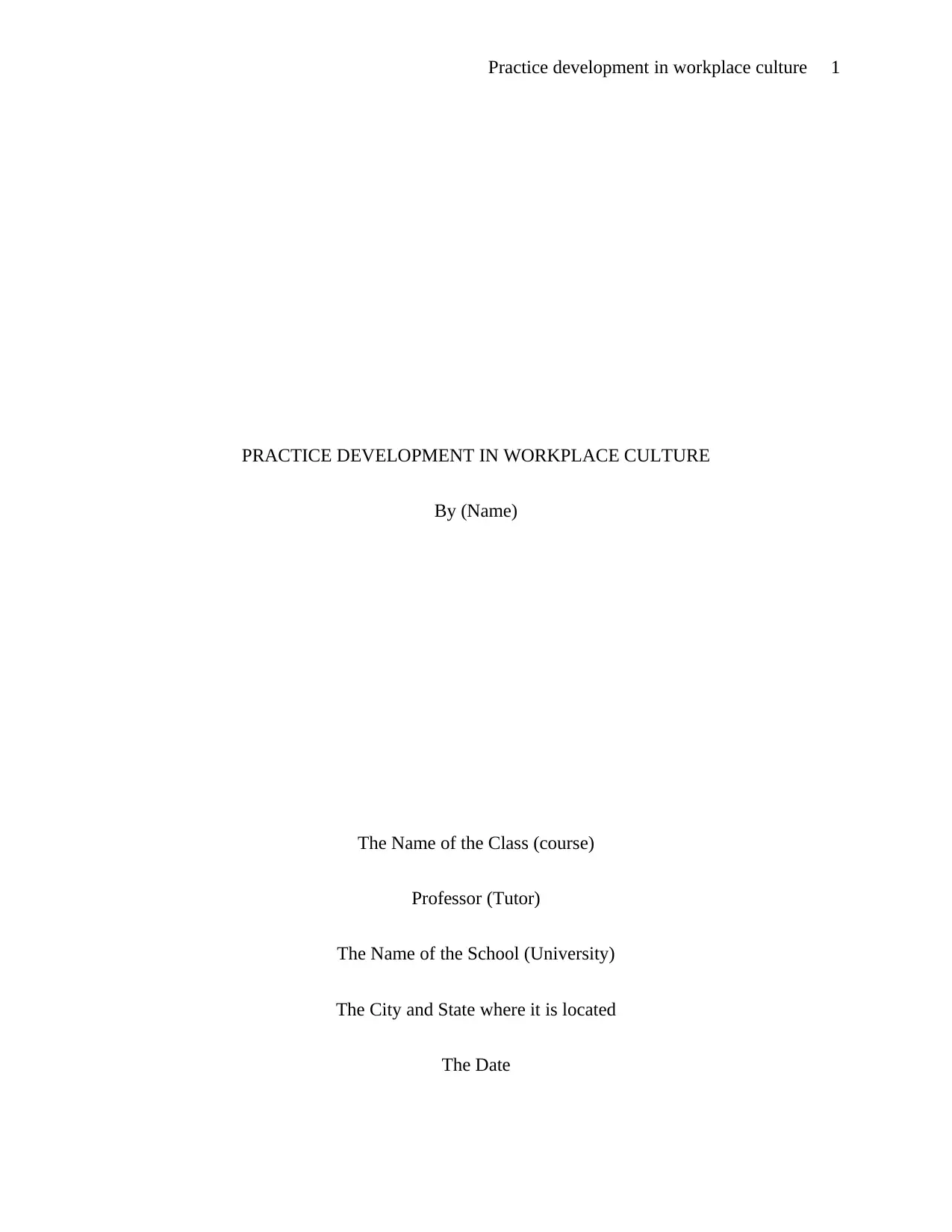
Practice development in workplace culture 1
PRACTICE DEVELOPMENT IN WORKPLACE CULTURE
By (Name)
The Name of the Class (course)
Professor (Tutor)
The Name of the School (University)
The City and State where it is located
The Date
PRACTICE DEVELOPMENT IN WORKPLACE CULTURE
By (Name)
The Name of the Class (course)
Professor (Tutor)
The Name of the School (University)
The City and State where it is located
The Date
Paraphrase This Document
Need a fresh take? Get an instant paraphrase of this document with our AI Paraphraser
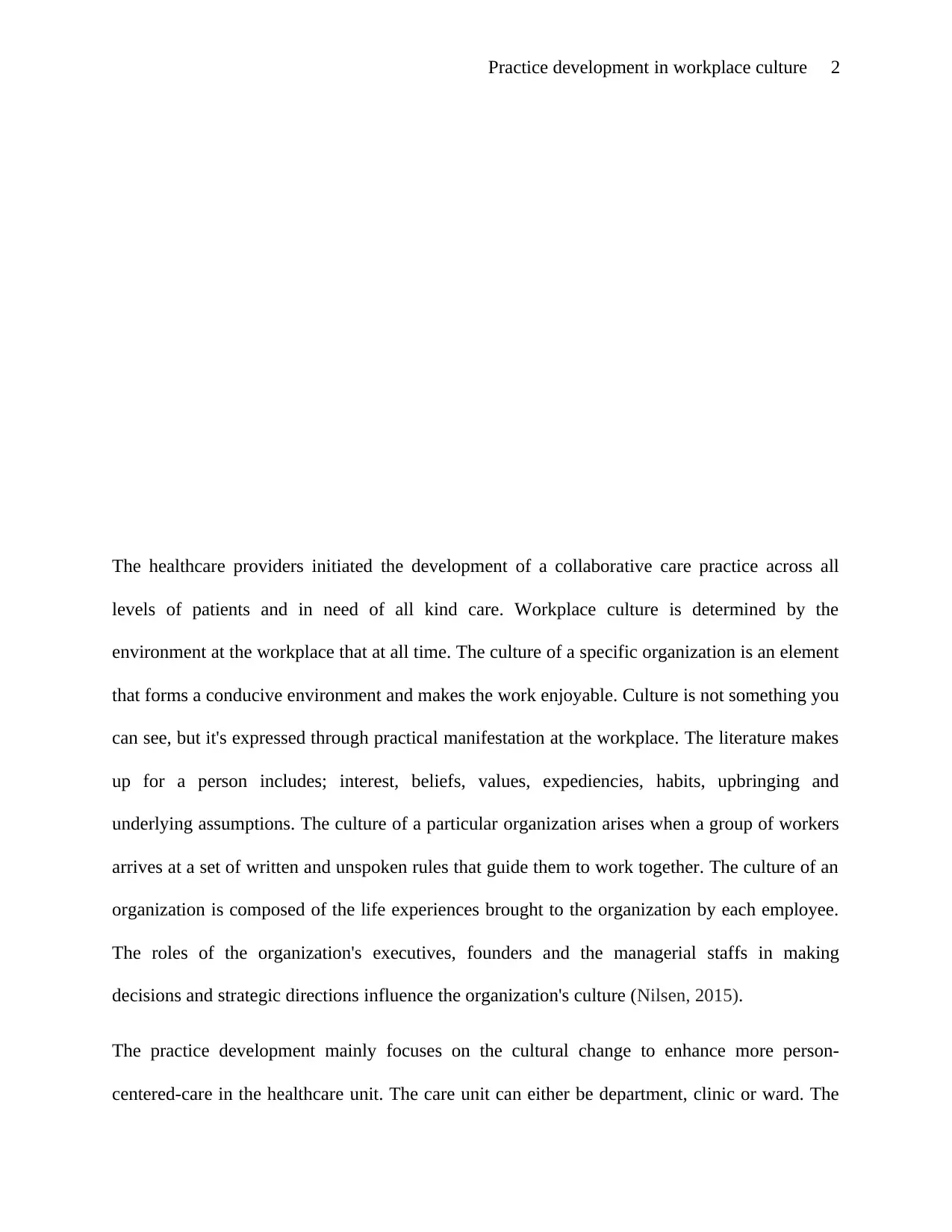
Practice development in workplace culture 2
The healthcare providers initiated the development of a collaborative care practice across all
levels of patients and in need of all kind care. Workplace culture is determined by the
environment at the workplace that at all time. The culture of a specific organization is an element
that forms a conducive environment and makes the work enjoyable. Culture is not something you
can see, but it's expressed through practical manifestation at the workplace. The literature makes
up for a person includes; interest, beliefs, values, expediencies, habits, upbringing and
underlying assumptions. The culture of a particular organization arises when a group of workers
arrives at a set of written and unspoken rules that guide them to work together. The culture of an
organization is composed of the life experiences brought to the organization by each employee.
The roles of the organization's executives, founders and the managerial staffs in making
decisions and strategic directions influence the organization's culture (Nilsen, 2015).
The practice development mainly focuses on the cultural change to enhance more person-
centered-care in the healthcare unit. The care unit can either be department, clinic or ward. The
The healthcare providers initiated the development of a collaborative care practice across all
levels of patients and in need of all kind care. Workplace culture is determined by the
environment at the workplace that at all time. The culture of a specific organization is an element
that forms a conducive environment and makes the work enjoyable. Culture is not something you
can see, but it's expressed through practical manifestation at the workplace. The literature makes
up for a person includes; interest, beliefs, values, expediencies, habits, upbringing and
underlying assumptions. The culture of a particular organization arises when a group of workers
arrives at a set of written and unspoken rules that guide them to work together. The culture of an
organization is composed of the life experiences brought to the organization by each employee.
The roles of the organization's executives, founders and the managerial staffs in making
decisions and strategic directions influence the organization's culture (Nilsen, 2015).
The practice development mainly focuses on the cultural change to enhance more person-
centered-care in the healthcare unit. The care unit can either be department, clinic or ward. The
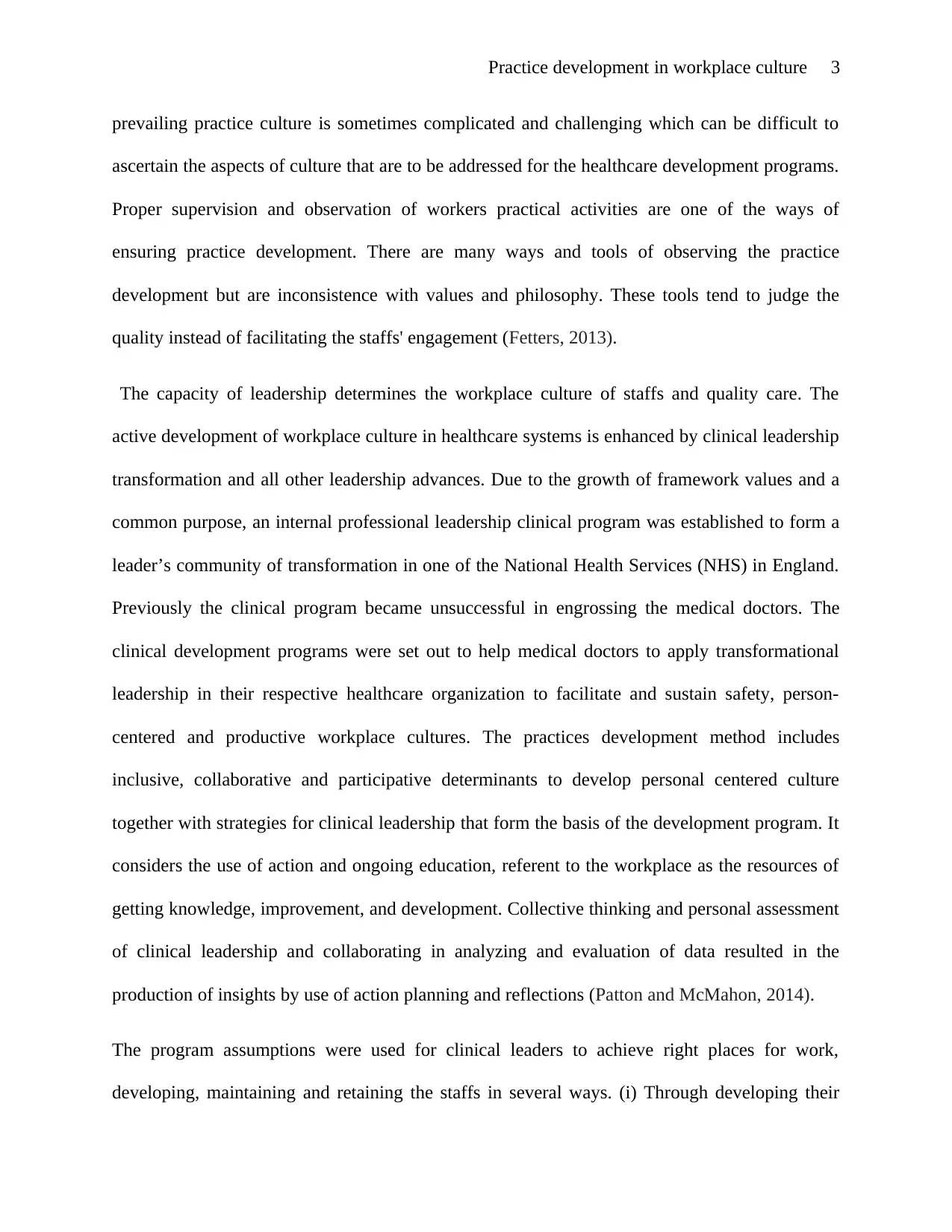
Practice development in workplace culture 3
prevailing practice culture is sometimes complicated and challenging which can be difficult to
ascertain the aspects of culture that are to be addressed for the healthcare development programs.
Proper supervision and observation of workers practical activities are one of the ways of
ensuring practice development. There are many ways and tools of observing the practice
development but are inconsistence with values and philosophy. These tools tend to judge the
quality instead of facilitating the staffs' engagement (Fetters, 2013).
The capacity of leadership determines the workplace culture of staffs and quality care. The
active development of workplace culture in healthcare systems is enhanced by clinical leadership
transformation and all other leadership advances. Due to the growth of framework values and a
common purpose, an internal professional leadership clinical program was established to form a
leader’s community of transformation in one of the National Health Services (NHS) in England.
Previously the clinical program became unsuccessful in engrossing the medical doctors. The
clinical development programs were set out to help medical doctors to apply transformational
leadership in their respective healthcare organization to facilitate and sustain safety, person-
centered and productive workplace cultures. The practices development method includes
inclusive, collaborative and participative determinants to develop personal centered culture
together with strategies for clinical leadership that form the basis of the development program. It
considers the use of action and ongoing education, referent to the workplace as the resources of
getting knowledge, improvement, and development. Collective thinking and personal assessment
of clinical leadership and collaborating in analyzing and evaluation of data resulted in the
production of insights by use of action planning and reflections (Patton and McMahon, 2014).
The program assumptions were used for clinical leaders to achieve right places for work,
developing, maintaining and retaining the staffs in several ways. (i) Through developing their
prevailing practice culture is sometimes complicated and challenging which can be difficult to
ascertain the aspects of culture that are to be addressed for the healthcare development programs.
Proper supervision and observation of workers practical activities are one of the ways of
ensuring practice development. There are many ways and tools of observing the practice
development but are inconsistence with values and philosophy. These tools tend to judge the
quality instead of facilitating the staffs' engagement (Fetters, 2013).
The capacity of leadership determines the workplace culture of staffs and quality care. The
active development of workplace culture in healthcare systems is enhanced by clinical leadership
transformation and all other leadership advances. Due to the growth of framework values and a
common purpose, an internal professional leadership clinical program was established to form a
leader’s community of transformation in one of the National Health Services (NHS) in England.
Previously the clinical program became unsuccessful in engrossing the medical doctors. The
clinical development programs were set out to help medical doctors to apply transformational
leadership in their respective healthcare organization to facilitate and sustain safety, person-
centered and productive workplace cultures. The practices development method includes
inclusive, collaborative and participative determinants to develop personal centered culture
together with strategies for clinical leadership that form the basis of the development program. It
considers the use of action and ongoing education, referent to the workplace as the resources of
getting knowledge, improvement, and development. Collective thinking and personal assessment
of clinical leadership and collaborating in analyzing and evaluation of data resulted in the
production of insights by use of action planning and reflections (Patton and McMahon, 2014).
The program assumptions were used for clinical leaders to achieve right places for work,
developing, maintaining and retaining the staffs in several ways. (i) Through developing their
⊘ This is a preview!⊘
Do you want full access?
Subscribe today to unlock all pages.

Trusted by 1+ million students worldwide
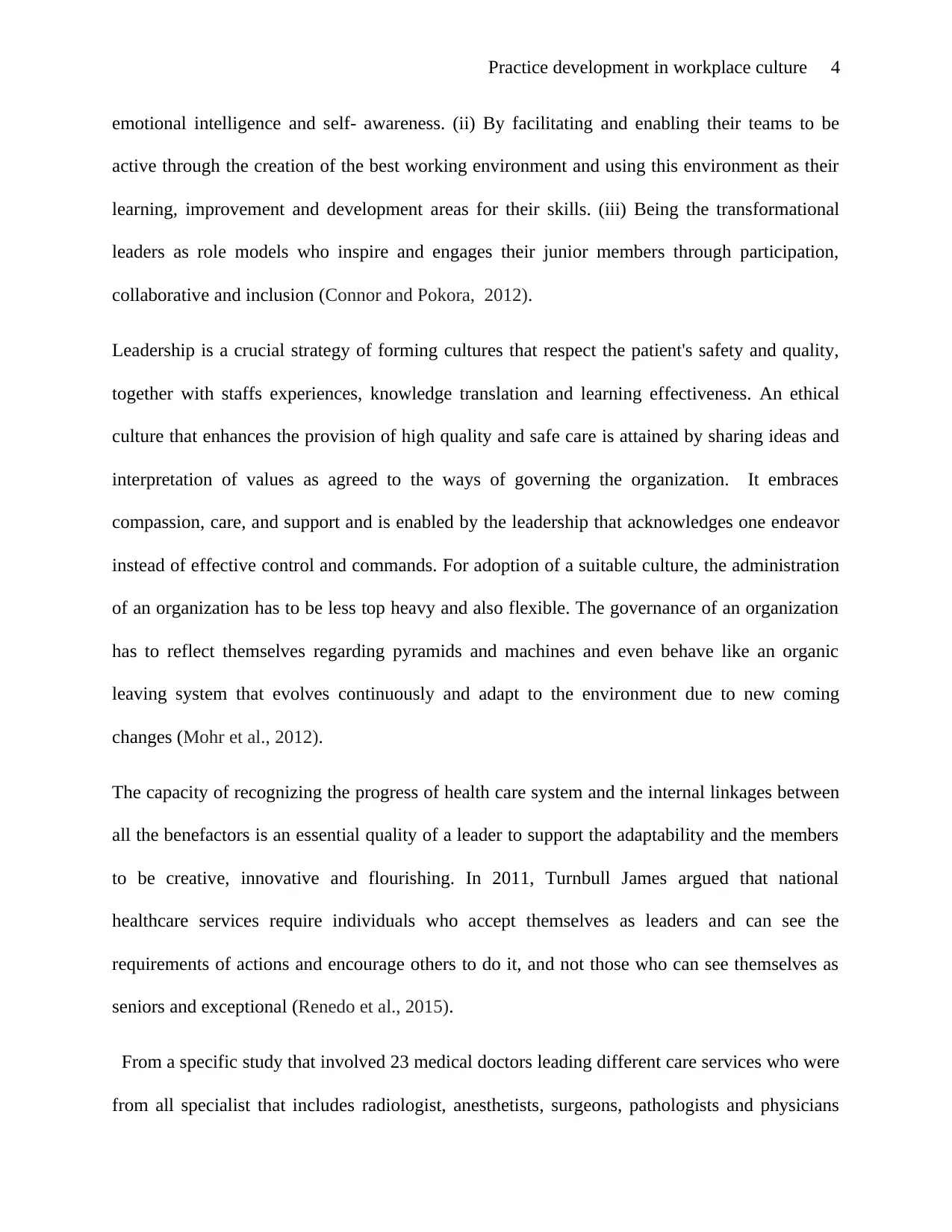
Practice development in workplace culture 4
emotional intelligence and self- awareness. (ii) By facilitating and enabling their teams to be
active through the creation of the best working environment and using this environment as their
learning, improvement and development areas for their skills. (iii) Being the transformational
leaders as role models who inspire and engages their junior members through participation,
collaborative and inclusion (Connor and Pokora, 2012).
Leadership is a crucial strategy of forming cultures that respect the patient's safety and quality,
together with staffs experiences, knowledge translation and learning effectiveness. An ethical
culture that enhances the provision of high quality and safe care is attained by sharing ideas and
interpretation of values as agreed to the ways of governing the organization. It embraces
compassion, care, and support and is enabled by the leadership that acknowledges one endeavor
instead of effective control and commands. For adoption of a suitable culture, the administration
of an organization has to be less top heavy and also flexible. The governance of an organization
has to reflect themselves regarding pyramids and machines and even behave like an organic
leaving system that evolves continuously and adapt to the environment due to new coming
changes (Mohr et al., 2012).
The capacity of recognizing the progress of health care system and the internal linkages between
all the benefactors is an essential quality of a leader to support the adaptability and the members
to be creative, innovative and flourishing. In 2011, Turnbull James argued that national
healthcare services require individuals who accept themselves as leaders and can see the
requirements of actions and encourage others to do it, and not those who can see themselves as
seniors and exceptional (Renedo et al., 2015).
From a specific study that involved 23 medical doctors leading different care services who were
from all specialist that includes radiologist, anesthetists, surgeons, pathologists and physicians
emotional intelligence and self- awareness. (ii) By facilitating and enabling their teams to be
active through the creation of the best working environment and using this environment as their
learning, improvement and development areas for their skills. (iii) Being the transformational
leaders as role models who inspire and engages their junior members through participation,
collaborative and inclusion (Connor and Pokora, 2012).
Leadership is a crucial strategy of forming cultures that respect the patient's safety and quality,
together with staffs experiences, knowledge translation and learning effectiveness. An ethical
culture that enhances the provision of high quality and safe care is attained by sharing ideas and
interpretation of values as agreed to the ways of governing the organization. It embraces
compassion, care, and support and is enabled by the leadership that acknowledges one endeavor
instead of effective control and commands. For adoption of a suitable culture, the administration
of an organization has to be less top heavy and also flexible. The governance of an organization
has to reflect themselves regarding pyramids and machines and even behave like an organic
leaving system that evolves continuously and adapt to the environment due to new coming
changes (Mohr et al., 2012).
The capacity of recognizing the progress of health care system and the internal linkages between
all the benefactors is an essential quality of a leader to support the adaptability and the members
to be creative, innovative and flourishing. In 2011, Turnbull James argued that national
healthcare services require individuals who accept themselves as leaders and can see the
requirements of actions and encourage others to do it, and not those who can see themselves as
seniors and exceptional (Renedo et al., 2015).
From a specific study that involved 23 medical doctors leading different care services who were
from all specialist that includes radiologist, anesthetists, surgeons, pathologists and physicians
Paraphrase This Document
Need a fresh take? Get an instant paraphrase of this document with our AI Paraphraser

Practice development in workplace culture 5
specialist. The study was outlining the program’s aims, underlying approach and learning
outcomes that were distributed across the whole organization. The participants were chosen by
the first come first choice, and they were to be underpinned by their senior managers to attend all
the sessions. Out of the 23 participants 18 only completed the program (Manley et al., 2014).
The collaborative insights programs help to note the effect of leadership in the working
environment to establish ways that will enable work to be celebratory, inclusive collaborative
and participative. The collaborative learning and reflections of the data program considered the
fact that only 18 participants out of the 23 were able to complete the application. There was also
a variable degree of practice among the participants in the program. The relevant outcomes of the
program were very essential for maintaining support for positive motivation and development.
An internal ideal for growing the capacity was noted as a single feature of the participants in the
program. The experiences of the participants aimed at developing and engaging the medical
doctors as clinical managers to form capacity and ability of clinical and overall leadership of the
organization. The culture of wellness and health are viewed as the foundations and factors that
affect positive communication, measurements and outcomes in a health sector (Marsick and
Watkins, 2015).
The culture, wellness, and environment are the main components of health sociological
framework used in Ohio State University that guides the evidence intervention and
measurements of results to attain the goal of becoming the best University regarding health in the
world (Thomas and Galla, 2013). In such a model several levels have to be included in positive
outcomes of the patients care, social network, culture environment and individual satisfaction.
The wellness of culture measurements is vital as research findings shown support in its
relationship with healthy behavioral lifestyles and the health outcomes. Several assessments were
specialist. The study was outlining the program’s aims, underlying approach and learning
outcomes that were distributed across the whole organization. The participants were chosen by
the first come first choice, and they were to be underpinned by their senior managers to attend all
the sessions. Out of the 23 participants 18 only completed the program (Manley et al., 2014).
The collaborative insights programs help to note the effect of leadership in the working
environment to establish ways that will enable work to be celebratory, inclusive collaborative
and participative. The collaborative learning and reflections of the data program considered the
fact that only 18 participants out of the 23 were able to complete the application. There was also
a variable degree of practice among the participants in the program. The relevant outcomes of the
program were very essential for maintaining support for positive motivation and development.
An internal ideal for growing the capacity was noted as a single feature of the participants in the
program. The experiences of the participants aimed at developing and engaging the medical
doctors as clinical managers to form capacity and ability of clinical and overall leadership of the
organization. The culture of wellness and health are viewed as the foundations and factors that
affect positive communication, measurements and outcomes in a health sector (Marsick and
Watkins, 2015).
The culture, wellness, and environment are the main components of health sociological
framework used in Ohio State University that guides the evidence intervention and
measurements of results to attain the goal of becoming the best University regarding health in the
world (Thomas and Galla, 2013). In such a model several levels have to be included in positive
outcomes of the patients care, social network, culture environment and individual satisfaction.
The wellness of culture measurements is vital as research findings shown support in its
relationship with healthy behavioral lifestyles and the health outcomes. Several assessments were
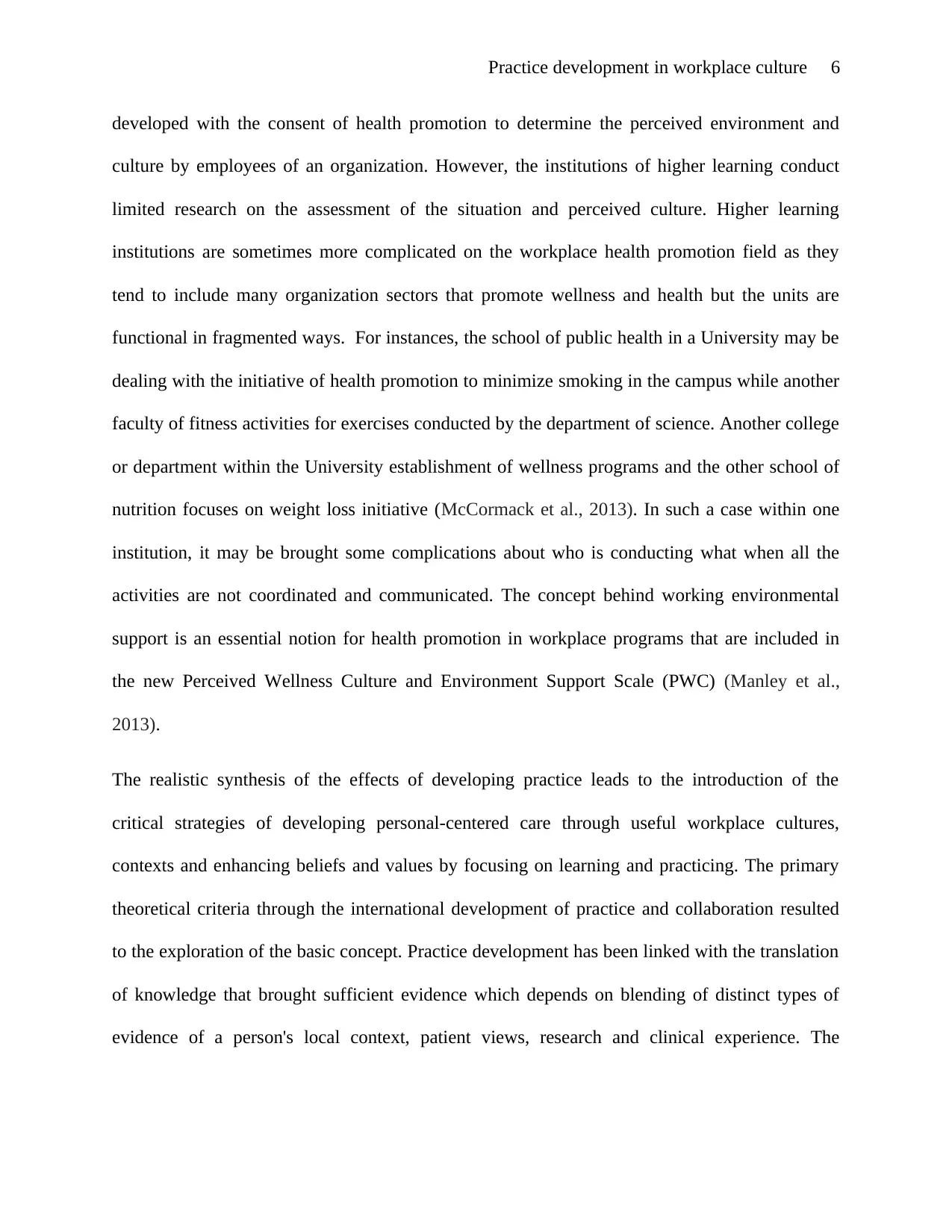
Practice development in workplace culture 6
developed with the consent of health promotion to determine the perceived environment and
culture by employees of an organization. However, the institutions of higher learning conduct
limited research on the assessment of the situation and perceived culture. Higher learning
institutions are sometimes more complicated on the workplace health promotion field as they
tend to include many organization sectors that promote wellness and health but the units are
functional in fragmented ways. For instances, the school of public health in a University may be
dealing with the initiative of health promotion to minimize smoking in the campus while another
faculty of fitness activities for exercises conducted by the department of science. Another college
or department within the University establishment of wellness programs and the other school of
nutrition focuses on weight loss initiative (McCormack et al., 2013). In such a case within one
institution, it may be brought some complications about who is conducting what when all the
activities are not coordinated and communicated. The concept behind working environmental
support is an essential notion for health promotion in workplace programs that are included in
the new Perceived Wellness Culture and Environment Support Scale (PWC) (Manley et al.,
2013).
The realistic synthesis of the effects of developing practice leads to the introduction of the
critical strategies of developing personal-centered care through useful workplace cultures,
contexts and enhancing beliefs and values by focusing on learning and practicing. The primary
theoretical criteria through the international development of practice and collaboration resulted
to the exploration of the basic concept. Practice development has been linked with the translation
of knowledge that brought sufficient evidence which depends on blending of distinct types of
evidence of a person's local context, patient views, research and clinical experience. The
developed with the consent of health promotion to determine the perceived environment and
culture by employees of an organization. However, the institutions of higher learning conduct
limited research on the assessment of the situation and perceived culture. Higher learning
institutions are sometimes more complicated on the workplace health promotion field as they
tend to include many organization sectors that promote wellness and health but the units are
functional in fragmented ways. For instances, the school of public health in a University may be
dealing with the initiative of health promotion to minimize smoking in the campus while another
faculty of fitness activities for exercises conducted by the department of science. Another college
or department within the University establishment of wellness programs and the other school of
nutrition focuses on weight loss initiative (McCormack et al., 2013). In such a case within one
institution, it may be brought some complications about who is conducting what when all the
activities are not coordinated and communicated. The concept behind working environmental
support is an essential notion for health promotion in workplace programs that are included in
the new Perceived Wellness Culture and Environment Support Scale (PWC) (Manley et al.,
2013).
The realistic synthesis of the effects of developing practice leads to the introduction of the
critical strategies of developing personal-centered care through useful workplace cultures,
contexts and enhancing beliefs and values by focusing on learning and practicing. The primary
theoretical criteria through the international development of practice and collaboration resulted
to the exploration of the basic concept. Practice development has been linked with the translation
of knowledge that brought sufficient evidence which depends on blending of distinct types of
evidence of a person's local context, patient views, research and clinical experience. The
⊘ This is a preview!⊘
Do you want full access?
Subscribe today to unlock all pages.

Trusted by 1+ million students worldwide
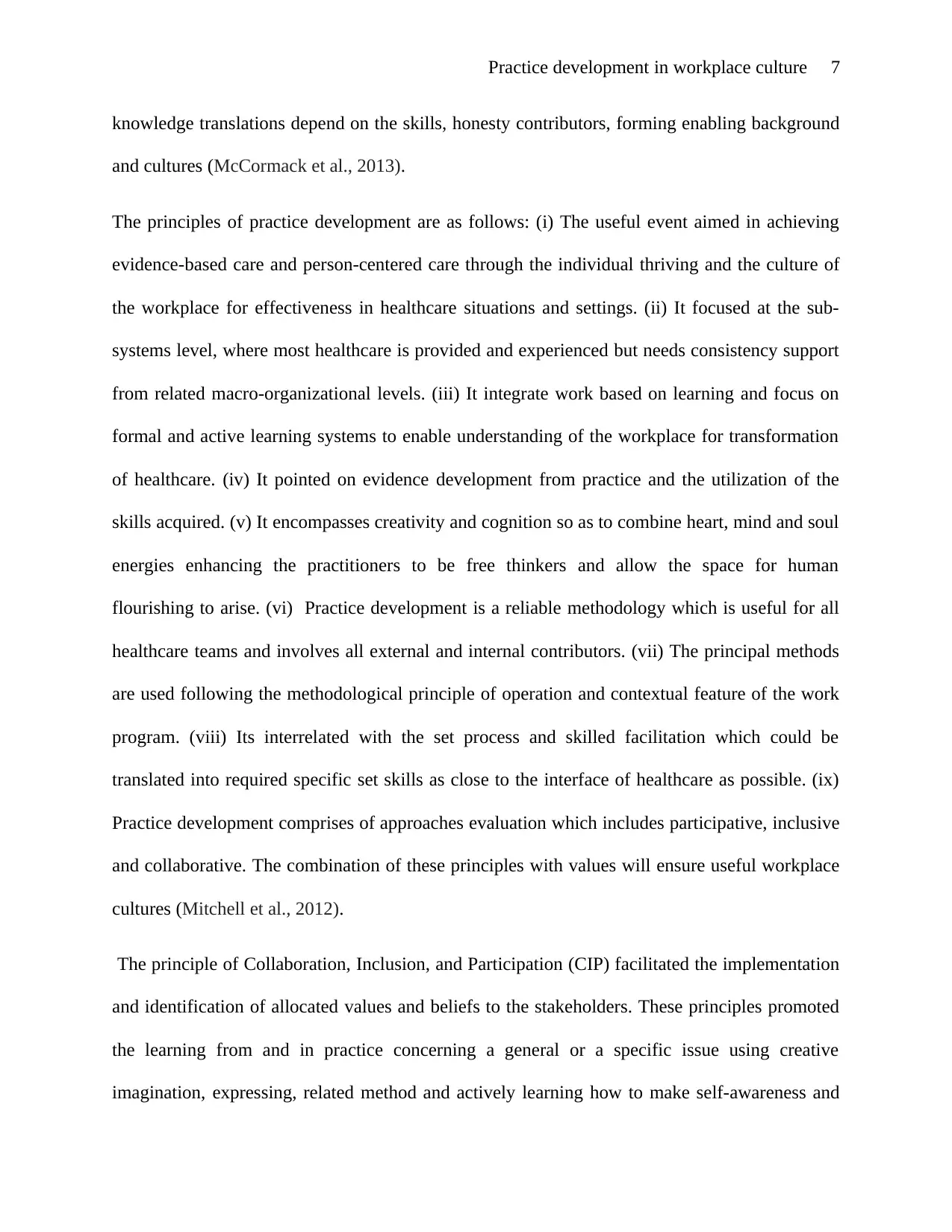
Practice development in workplace culture 7
knowledge translations depend on the skills, honesty contributors, forming enabling background
and cultures (McCormack et al., 2013).
The principles of practice development are as follows: (i) The useful event aimed in achieving
evidence-based care and person-centered care through the individual thriving and the culture of
the workplace for effectiveness in healthcare situations and settings. (ii) It focused at the sub-
systems level, where most healthcare is provided and experienced but needs consistency support
from related macro-organizational levels. (iii) It integrate work based on learning and focus on
formal and active learning systems to enable understanding of the workplace for transformation
of healthcare. (iv) It pointed on evidence development from practice and the utilization of the
skills acquired. (v) It encompasses creativity and cognition so as to combine heart, mind and soul
energies enhancing the practitioners to be free thinkers and allow the space for human
flourishing to arise. (vi) Practice development is a reliable methodology which is useful for all
healthcare teams and involves all external and internal contributors. (vii) The principal methods
are used following the methodological principle of operation and contextual feature of the work
program. (viii) Its interrelated with the set process and skilled facilitation which could be
translated into required specific set skills as close to the interface of healthcare as possible. (ix)
Practice development comprises of approaches evaluation which includes participative, inclusive
and collaborative. The combination of these principles with values will ensure useful workplace
cultures (Mitchell et al., 2012).
The principle of Collaboration, Inclusion, and Participation (CIP) facilitated the implementation
and identification of allocated values and beliefs to the stakeholders. These principles promoted
the learning from and in practice concerning a general or a specific issue using creative
imagination, expressing, related method and actively learning how to make self-awareness and
knowledge translations depend on the skills, honesty contributors, forming enabling background
and cultures (McCormack et al., 2013).
The principles of practice development are as follows: (i) The useful event aimed in achieving
evidence-based care and person-centered care through the individual thriving and the culture of
the workplace for effectiveness in healthcare situations and settings. (ii) It focused at the sub-
systems level, where most healthcare is provided and experienced but needs consistency support
from related macro-organizational levels. (iii) It integrate work based on learning and focus on
formal and active learning systems to enable understanding of the workplace for transformation
of healthcare. (iv) It pointed on evidence development from practice and the utilization of the
skills acquired. (v) It encompasses creativity and cognition so as to combine heart, mind and soul
energies enhancing the practitioners to be free thinkers and allow the space for human
flourishing to arise. (vi) Practice development is a reliable methodology which is useful for all
healthcare teams and involves all external and internal contributors. (vii) The principal methods
are used following the methodological principle of operation and contextual feature of the work
program. (viii) Its interrelated with the set process and skilled facilitation which could be
translated into required specific set skills as close to the interface of healthcare as possible. (ix)
Practice development comprises of approaches evaluation which includes participative, inclusive
and collaborative. The combination of these principles with values will ensure useful workplace
cultures (Mitchell et al., 2012).
The principle of Collaboration, Inclusion, and Participation (CIP) facilitated the implementation
and identification of allocated values and beliefs to the stakeholders. These principles promoted
the learning from and in practice concerning a general or a specific issue using creative
imagination, expressing, related method and actively learning how to make self-awareness and
Paraphrase This Document
Need a fresh take? Get an instant paraphrase of this document with our AI Paraphraser

Practice development in workplace culture 8
motivates the application of these shared values. The CIP principles also allow for systemic
change using several multiple sources. The shared purpose occurs when the team of individuals
adheres to one belief system with a single goal or vision (Huxham and Vangen, 2013).
The shared objective is a robust strategy for cooperating groups of stakeholders in collaborative
initiatives, enhancing every individual to perform creatively towards similar direction while
embracing the agreed values for example provision of shared decision – making and encouraging
people to have a heart of care. The shared purpose enhanced non-collaborative working, barriers,
silos and incompatible agendas to be overcome and challenged (Stiggelbout et al., 2012). The
clarification of the use led to compatibility on the way that purposes can be attained and what it
means for working directions and priorities. One of the primary activity of practice development
at work and as one of its fundamental principles is developing the shared purpose. The range of
approaches that are used to achieve the values clarification of the policy through the use of
college, dance, poetry, and visualization. The complex intervention of practice development
integrates the system development practice together with the support of practitioners and the
change of culture to sustain specific outcomes. A purpose that is shared attributes to a productive
work culture due to the shared values. Since the concept of the 1980s, the practice improvement
focused on gaining of evidence-informed care and personal- centered care, even though recent
refinements endorsed the flourishing human idea and implemented the worksite cultures to make
each flourish (McCormack and McCance, 2016).
The principle of (CIP) develops the ownership of direction, change and also self- empowerment.
The agreed beliefs and values to be achieved and methods of working which gives support of
reference that enhances self-direction, the comfort of decided values, behaviors and mutual
challenge. Involving all the staffs in decision making accords value to them and allows
motivates the application of these shared values. The CIP principles also allow for systemic
change using several multiple sources. The shared purpose occurs when the team of individuals
adheres to one belief system with a single goal or vision (Huxham and Vangen, 2013).
The shared objective is a robust strategy for cooperating groups of stakeholders in collaborative
initiatives, enhancing every individual to perform creatively towards similar direction while
embracing the agreed values for example provision of shared decision – making and encouraging
people to have a heart of care. The shared purpose enhanced non-collaborative working, barriers,
silos and incompatible agendas to be overcome and challenged (Stiggelbout et al., 2012). The
clarification of the use led to compatibility on the way that purposes can be attained and what it
means for working directions and priorities. One of the primary activity of practice development
at work and as one of its fundamental principles is developing the shared purpose. The range of
approaches that are used to achieve the values clarification of the policy through the use of
college, dance, poetry, and visualization. The complex intervention of practice development
integrates the system development practice together with the support of practitioners and the
change of culture to sustain specific outcomes. A purpose that is shared attributes to a productive
work culture due to the shared values. Since the concept of the 1980s, the practice improvement
focused on gaining of evidence-informed care and personal- centered care, even though recent
refinements endorsed the flourishing human idea and implemented the worksite cultures to make
each flourish (McCormack and McCance, 2016).
The principle of (CIP) develops the ownership of direction, change and also self- empowerment.
The agreed beliefs and values to be achieved and methods of working which gives support of
reference that enhances self-direction, the comfort of decided values, behaviors and mutual
challenge. Involving all the staffs in decision making accords value to them and allows
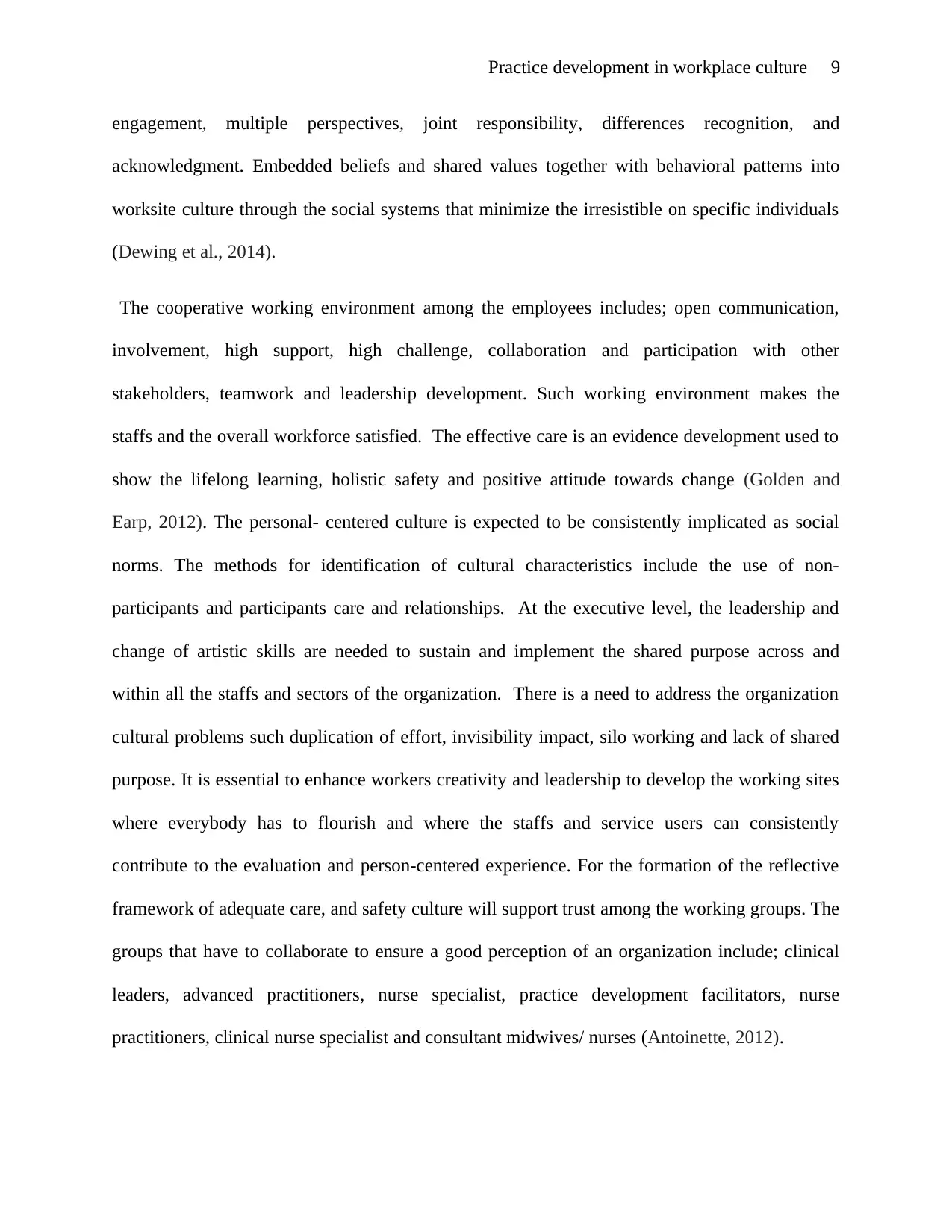
Practice development in workplace culture 9
engagement, multiple perspectives, joint responsibility, differences recognition, and
acknowledgment. Embedded beliefs and shared values together with behavioral patterns into
worksite culture through the social systems that minimize the irresistible on specific individuals
(Dewing et al., 2014).
The cooperative working environment among the employees includes; open communication,
involvement, high support, high challenge, collaboration and participation with other
stakeholders, teamwork and leadership development. Such working environment makes the
staffs and the overall workforce satisfied. The effective care is an evidence development used to
show the lifelong learning, holistic safety and positive attitude towards change (Golden and
Earp, 2012). The personal- centered culture is expected to be consistently implicated as social
norms. The methods for identification of cultural characteristics include the use of non-
participants and participants care and relationships. At the executive level, the leadership and
change of artistic skills are needed to sustain and implement the shared purpose across and
within all the staffs and sectors of the organization. There is a need to address the organization
cultural problems such duplication of effort, invisibility impact, silo working and lack of shared
purpose. It is essential to enhance workers creativity and leadership to develop the working sites
where everybody has to flourish and where the staffs and service users can consistently
contribute to the evaluation and person-centered experience. For the formation of the reflective
framework of adequate care, and safety culture will support trust among the working groups. The
groups that have to collaborate to ensure a good perception of an organization include; clinical
leaders, advanced practitioners, nurse specialist, practice development facilitators, nurse
practitioners, clinical nurse specialist and consultant midwives/ nurses (Antoinette, 2012).
engagement, multiple perspectives, joint responsibility, differences recognition, and
acknowledgment. Embedded beliefs and shared values together with behavioral patterns into
worksite culture through the social systems that minimize the irresistible on specific individuals
(Dewing et al., 2014).
The cooperative working environment among the employees includes; open communication,
involvement, high support, high challenge, collaboration and participation with other
stakeholders, teamwork and leadership development. Such working environment makes the
staffs and the overall workforce satisfied. The effective care is an evidence development used to
show the lifelong learning, holistic safety and positive attitude towards change (Golden and
Earp, 2012). The personal- centered culture is expected to be consistently implicated as social
norms. The methods for identification of cultural characteristics include the use of non-
participants and participants care and relationships. At the executive level, the leadership and
change of artistic skills are needed to sustain and implement the shared purpose across and
within all the staffs and sectors of the organization. There is a need to address the organization
cultural problems such duplication of effort, invisibility impact, silo working and lack of shared
purpose. It is essential to enhance workers creativity and leadership to develop the working sites
where everybody has to flourish and where the staffs and service users can consistently
contribute to the evaluation and person-centered experience. For the formation of the reflective
framework of adequate care, and safety culture will support trust among the working groups. The
groups that have to collaborate to ensure a good perception of an organization include; clinical
leaders, advanced practitioners, nurse specialist, practice development facilitators, nurse
practitioners, clinical nurse specialist and consultant midwives/ nurses (Antoinette, 2012).
⊘ This is a preview!⊘
Do you want full access?
Subscribe today to unlock all pages.

Trusted by 1+ million students worldwide
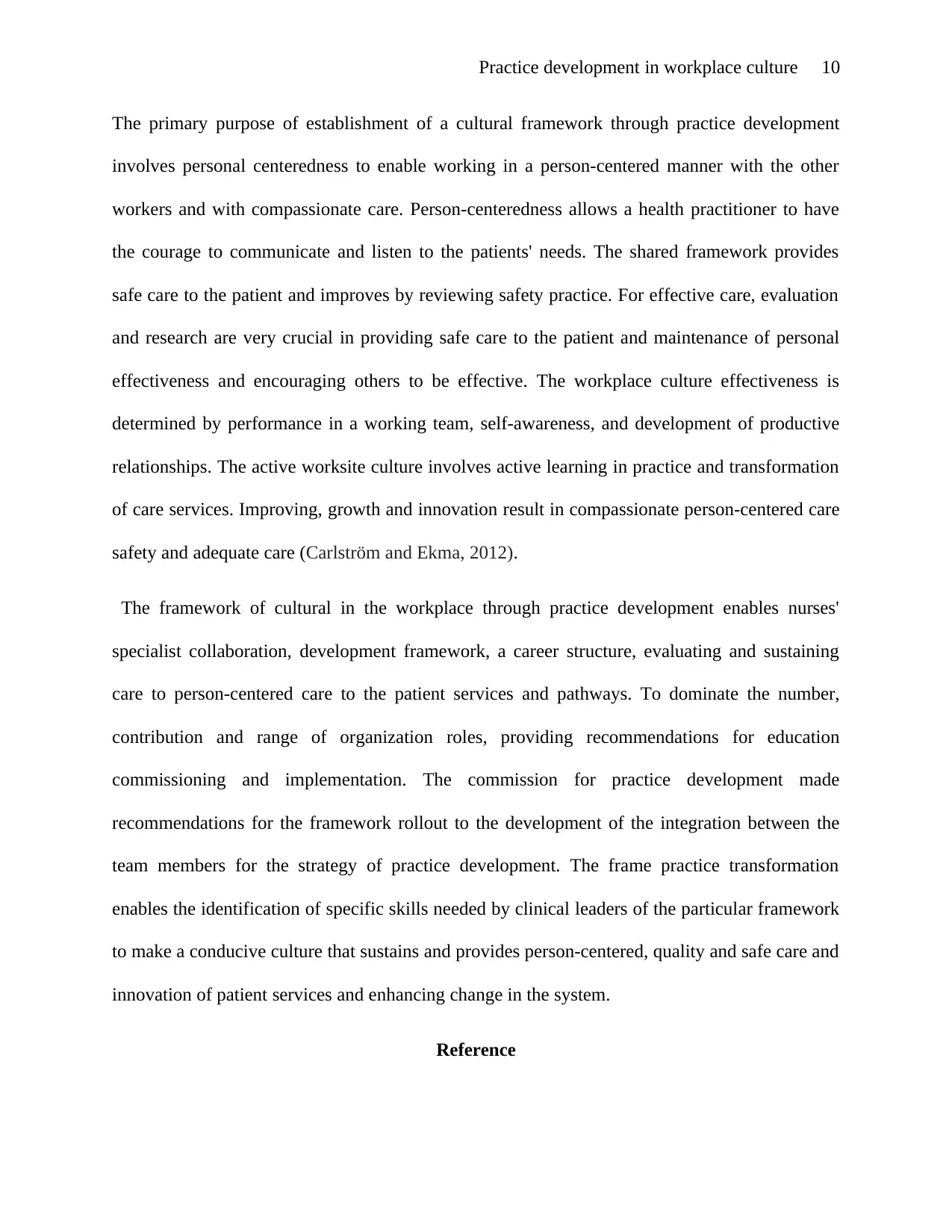
Practice development in workplace culture 10
The primary purpose of establishment of a cultural framework through practice development
involves personal centeredness to enable working in a person-centered manner with the other
workers and with compassionate care. Person-centeredness allows a health practitioner to have
the courage to communicate and listen to the patients' needs. The shared framework provides
safe care to the patient and improves by reviewing safety practice. For effective care, evaluation
and research are very crucial in providing safe care to the patient and maintenance of personal
effectiveness and encouraging others to be effective. The workplace culture effectiveness is
determined by performance in a working team, self-awareness, and development of productive
relationships. The active worksite culture involves active learning in practice and transformation
of care services. Improving, growth and innovation result in compassionate person-centered care
safety and adequate care (Carlström and Ekma, 2012).
The framework of cultural in the workplace through practice development enables nurses'
specialist collaboration, development framework, a career structure, evaluating and sustaining
care to person-centered care to the patient services and pathways. To dominate the number,
contribution and range of organization roles, providing recommendations for education
commissioning and implementation. The commission for practice development made
recommendations for the framework rollout to the development of the integration between the
team members for the strategy of practice development. The frame practice transformation
enables the identification of specific skills needed by clinical leaders of the particular framework
to make a conducive culture that sustains and provides person-centered, quality and safe care and
innovation of patient services and enhancing change in the system.
Reference
The primary purpose of establishment of a cultural framework through practice development
involves personal centeredness to enable working in a person-centered manner with the other
workers and with compassionate care. Person-centeredness allows a health practitioner to have
the courage to communicate and listen to the patients' needs. The shared framework provides
safe care to the patient and improves by reviewing safety practice. For effective care, evaluation
and research are very crucial in providing safe care to the patient and maintenance of personal
effectiveness and encouraging others to be effective. The workplace culture effectiveness is
determined by performance in a working team, self-awareness, and development of productive
relationships. The active worksite culture involves active learning in practice and transformation
of care services. Improving, growth and innovation result in compassionate person-centered care
safety and adequate care (Carlström and Ekma, 2012).
The framework of cultural in the workplace through practice development enables nurses'
specialist collaboration, development framework, a career structure, evaluating and sustaining
care to person-centered care to the patient services and pathways. To dominate the number,
contribution and range of organization roles, providing recommendations for education
commissioning and implementation. The commission for practice development made
recommendations for the framework rollout to the development of the integration between the
team members for the strategy of practice development. The frame practice transformation
enables the identification of specific skills needed by clinical leaders of the particular framework
to make a conducive culture that sustains and provides person-centered, quality and safe care and
innovation of patient services and enhancing change in the system.
Reference
Paraphrase This Document
Need a fresh take? Get an instant paraphrase of this document with our AI Paraphraser
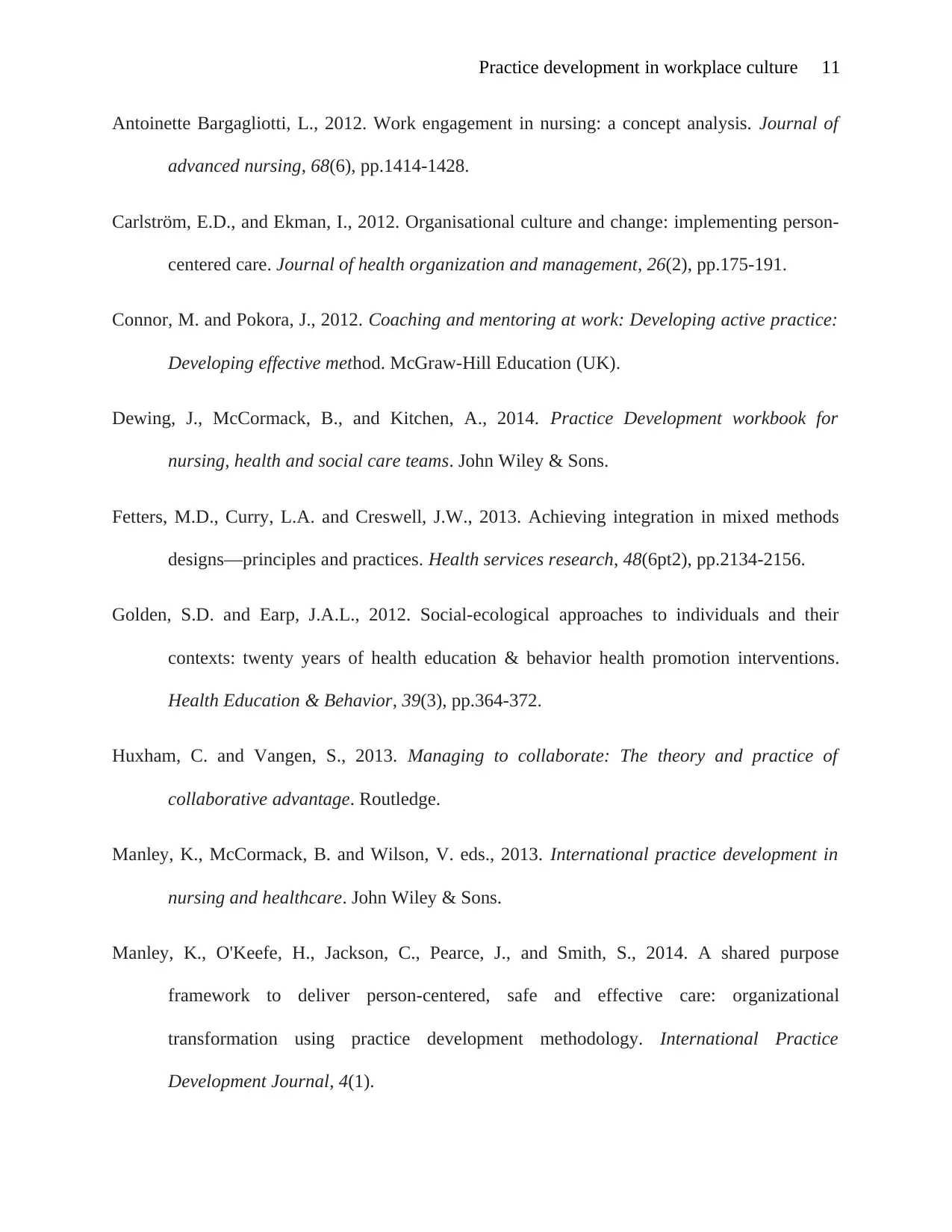
Practice development in workplace culture 11
Antoinette Bargagliotti, L., 2012. Work engagement in nursing: a concept analysis. Journal of
advanced nursing, 68(6), pp.1414-1428.
Carlström, E.D., and Ekman, I., 2012. Organisational culture and change: implementing person-
centered care. Journal of health organization and management, 26(2), pp.175-191.
Connor, M. and Pokora, J., 2012. Coaching and mentoring at work: Developing active practice:
Developing effective method. McGraw-Hill Education (UK).
Dewing, J., McCormack, B., and Kitchen, A., 2014. Practice Development workbook for
nursing, health and social care teams. John Wiley & Sons.
Fetters, M.D., Curry, L.A. and Creswell, J.W., 2013. Achieving integration in mixed methods
designs—principles and practices. Health services research, 48(6pt2), pp.2134-2156.
Golden, S.D. and Earp, J.A.L., 2012. Social-ecological approaches to individuals and their
contexts: twenty years of health education & behavior health promotion interventions.
Health Education & Behavior, 39(3), pp.364-372.
Huxham, C. and Vangen, S., 2013. Managing to collaborate: The theory and practice of
collaborative advantage. Routledge.
Manley, K., McCormack, B. and Wilson, V. eds., 2013. International practice development in
nursing and healthcare. John Wiley & Sons.
Manley, K., O'Keefe, H., Jackson, C., Pearce, J., and Smith, S., 2014. A shared purpose
framework to deliver person-centered, safe and effective care: organizational
transformation using practice development methodology. International Practice
Development Journal, 4(1).
Antoinette Bargagliotti, L., 2012. Work engagement in nursing: a concept analysis. Journal of
advanced nursing, 68(6), pp.1414-1428.
Carlström, E.D., and Ekman, I., 2012. Organisational culture and change: implementing person-
centered care. Journal of health organization and management, 26(2), pp.175-191.
Connor, M. and Pokora, J., 2012. Coaching and mentoring at work: Developing active practice:
Developing effective method. McGraw-Hill Education (UK).
Dewing, J., McCormack, B., and Kitchen, A., 2014. Practice Development workbook for
nursing, health and social care teams. John Wiley & Sons.
Fetters, M.D., Curry, L.A. and Creswell, J.W., 2013. Achieving integration in mixed methods
designs—principles and practices. Health services research, 48(6pt2), pp.2134-2156.
Golden, S.D. and Earp, J.A.L., 2012. Social-ecological approaches to individuals and their
contexts: twenty years of health education & behavior health promotion interventions.
Health Education & Behavior, 39(3), pp.364-372.
Huxham, C. and Vangen, S., 2013. Managing to collaborate: The theory and practice of
collaborative advantage. Routledge.
Manley, K., McCormack, B. and Wilson, V. eds., 2013. International practice development in
nursing and healthcare. John Wiley & Sons.
Manley, K., O'Keefe, H., Jackson, C., Pearce, J., and Smith, S., 2014. A shared purpose
framework to deliver person-centered, safe and effective care: organizational
transformation using practice development methodology. International Practice
Development Journal, 4(1).

Practice development in workplace culture 12
Marsick, V. and Watkins, K., 2015. Informal and incidental learning in the workplace
(Routledge Revivals). Routledge.
McCormack, B. and McCance, T. eds., 2016. Person-centered practice in nursing and health
care: Theory and practice. John Wiley & Sons.
McCormack, B., Manley, K. and Kitchen, A. eds., 2013. Practice development in nursing and
healthcare. John Wiley & Sons.
McCormack, B., Rycroft-Malone, J., DeCorby, K., Hutchinson, A.M., Bucknall, T., Kent, B.,
Schultz, A., Snelgrove-Clarke, E., Stetler, C., Titler, M. and Wallin, L., 2013. A realist
review of interventions and strategies to promote evidence-informed healthcare: a focus
on change agency. Implementation Science, 8(1), p.107.
Patton, W. and McMahon, M., 2014. Career development and systems theory: Connecting
theory and practice (Vol. 2). Springer.
Stiggelbout, A.M., Van der Weijden, T., De Wit, M.P., Frosch, D., Légaré, F., Montori, V.M.,
Trevena, L. and Elwyn, G., 2012. Shared decision making: putting patients at the center
of healthcare. BMJ, 344, p.e256.
Thomas, L. and Galla, C., 2013. Building a culture of safety through team training and
engagement. BMJ Qual Saf, 22(5), pp.425-434.
Mitchell, P., Wynia, M., Golden, R., McNellis, B., Okun, S., Webb, C.E., Rohrbach, V. and Von
Kohorn, I., 2012. Core principles & values of effective team-based health care.
Washington, DC: Institute of Medicine.
Marsick, V. and Watkins, K., 2015. Informal and incidental learning in the workplace
(Routledge Revivals). Routledge.
McCormack, B. and McCance, T. eds., 2016. Person-centered practice in nursing and health
care: Theory and practice. John Wiley & Sons.
McCormack, B., Manley, K. and Kitchen, A. eds., 2013. Practice development in nursing and
healthcare. John Wiley & Sons.
McCormack, B., Rycroft-Malone, J., DeCorby, K., Hutchinson, A.M., Bucknall, T., Kent, B.,
Schultz, A., Snelgrove-Clarke, E., Stetler, C., Titler, M. and Wallin, L., 2013. A realist
review of interventions and strategies to promote evidence-informed healthcare: a focus
on change agency. Implementation Science, 8(1), p.107.
Patton, W. and McMahon, M., 2014. Career development and systems theory: Connecting
theory and practice (Vol. 2). Springer.
Stiggelbout, A.M., Van der Weijden, T., De Wit, M.P., Frosch, D., Légaré, F., Montori, V.M.,
Trevena, L. and Elwyn, G., 2012. Shared decision making: putting patients at the center
of healthcare. BMJ, 344, p.e256.
Thomas, L. and Galla, C., 2013. Building a culture of safety through team training and
engagement. BMJ Qual Saf, 22(5), pp.425-434.
Mitchell, P., Wynia, M., Golden, R., McNellis, B., Okun, S., Webb, C.E., Rohrbach, V. and Von
Kohorn, I., 2012. Core principles & values of effective team-based health care.
Washington, DC: Institute of Medicine.
⊘ This is a preview!⊘
Do you want full access?
Subscribe today to unlock all pages.

Trusted by 1+ million students worldwide
1 out of 13
Related Documents
Your All-in-One AI-Powered Toolkit for Academic Success.
+13062052269
info@desklib.com
Available 24*7 on WhatsApp / Email
![[object Object]](/_next/static/media/star-bottom.7253800d.svg)
Unlock your academic potential
Copyright © 2020–2025 A2Z Services. All Rights Reserved. Developed and managed by ZUCOL.





